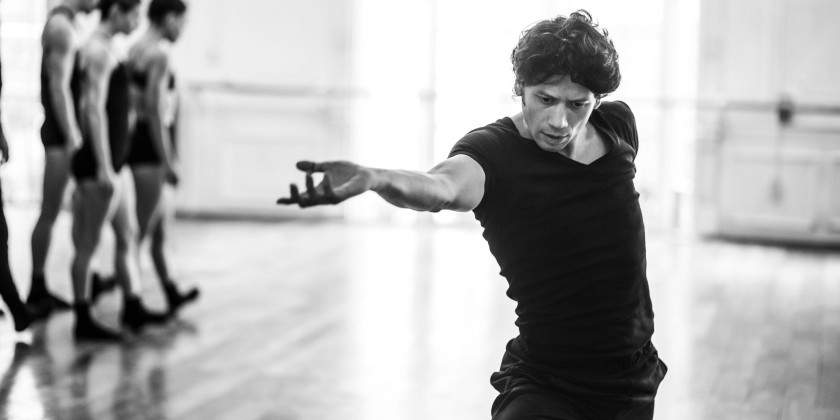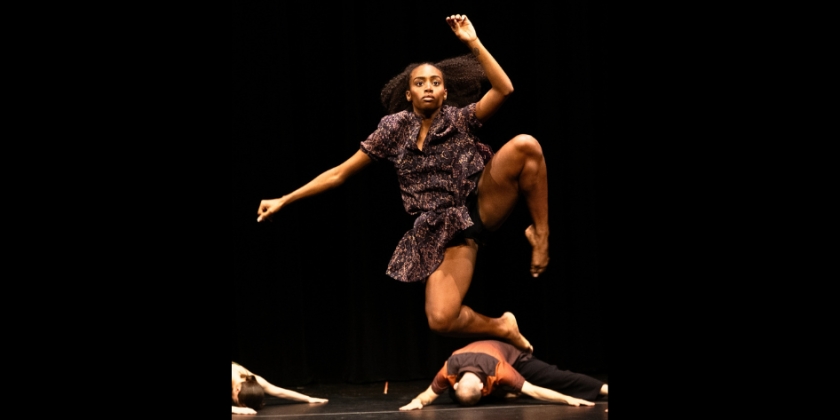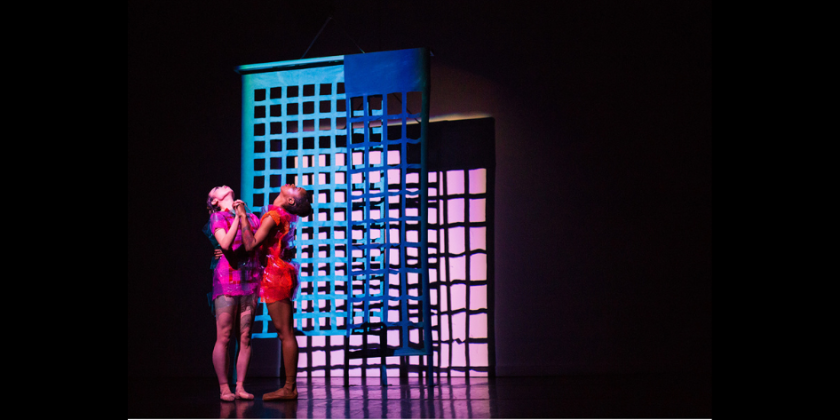IMPRESSIONS: Compagnie Hervé Koubi's “What the Day Owes to the Night” at The Joyce

January 30, 2018
Choreography: Herve Koubi
Artists: Mohammed Elhilali, Adil Bousbara, Abdelghani Ferradji, Zakaria Ghezal, Bendehiba Maamar, Giovanni Martinat, Nadjib Meherhera, Riad Mendjel, Mourad Messaoud, Houssni Mijem, Ismail Oubbajaddi, Issa Sanou, El Houssaini Zahid
Music: Sufi music, and music by Maxime Bodson, Hamza El Din with Kronos Quartet and Jean-Sebastien Bach
Lighting Design: Lional Buzonie
Costume Design: Guillaume Gabriel
Pictured above: Compagnie Hervé KOUBI in the New York premiere of "What the Day Owes to the Night" at The Joyce Theater.
Thirteen bare-chested men, street dancers from Algeria and Burkina Faso, seem perfectly at home onstage of The Joyce Theater in Compagnie Hervé Koubi’s What the Day Owes to the Night. The French company made its New York premiere to a packed house, weaving together capoeira, martial arts, and contemporary dance to create a 65-minute meditation on connectedness and isolation. The piece transports us out of the city to a place where the undulating rhythm of nature dominates.
In an endearing introduction, Koubi tells us he learned at age 25 that his father was not from France but Algeria. The piece’s title comes from Yasmina Khadra’s novel about a young man caught between Algerian and European worlds, which is echoed in this exploration of Koubi’s newfound heritage.
Light enters the stage like the sun rising over the desert, revealing a puddle of dancers on the ground. As if a multi-limbed creature extending sensors to test the air, tentacle-like arms emerge, and layers of buff skin and white cloth slowly take the form of men in flowing white skirts and culottes.

The cast moves with primitive impulses to match the driving beat of the music, an eclectic score that includes Johann Sebastian Bach, Hamza El Din, the Kronos Quartet, and traditional Sufi music. With no hesitation, the men propel and suspend their powerful bodies in shooting leaps and aerials. In one repeated motif, they spin on their heads, conjuring images of the Sufi whirling dervishes. As the action traverses the center of the stage, other dancers wander solemnly on the outskirts, unaffected.
The impressive choreography contains a theatrical magic, but it doesn’t feel virtuosic or like the men are doing “tricks.” Rather, the movement has an organic quality reminiscent of feats of nature, like a spiraling dust storm or a tsunami gathering momentum. Moments of chaos conjure up imagery of a torrential rainstorm as bodies flip and fly through the air.
Demonstrations of vulnerability punctuate the unabashed masculinity. One man soars into the arms of a fellow dancer, landing with limbs splayed wide, head flung back and throat exposed. Often, the men interact with tenderness, delicately adjusting another’s costumes as they get tossed and twisted.

Throughout, each man finds himself alone among the crowd, yet no hierarchy emerges. Seemingly, this is not the tale of one specific man, but rather a universal human story. In a memorable scenario, the dancers pile together to create a human sculpture. One man ascends them as though scurrying up a mountain. Carefully balanced at the top, he points to the sky in a gesture of celebration. The audience gasps as he leans backwards, appearing to linger in the air for seconds before tumbling into the arms of his fellow dancers, who lower him softly to the ground.
Toward the end, the music gets quieter, conveying a dreamy nostalgia, like a radio playing through an open window across a courtyard. In a hauntingly beautiful culmination, the group achieves union for the first time yet, kneeling on the ground in a gesture of reverence. Slowly, they transition into headstands, legs suspended in the air like branches of trees.
What the Day Owes the Night billows and contracts like the swell of the ocean. It doesn’t progress so much as wraps us up in a constant winding and unwinding to suggest an infinity that cleanses us.













